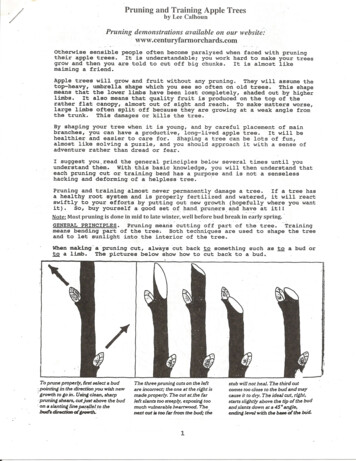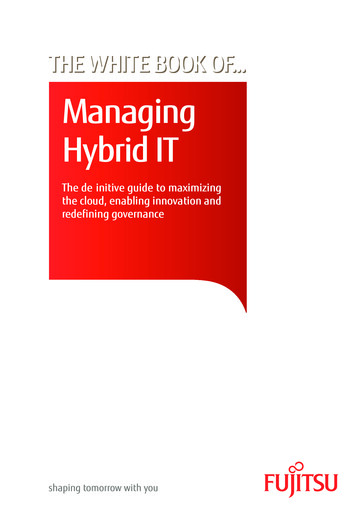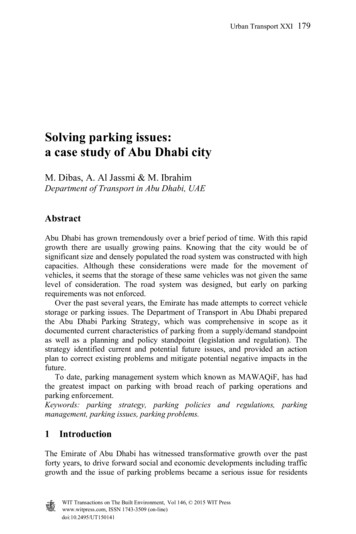
Transcription
Growing Pains
Outcomes Understand what laws apply to you in yourcurrent size General information on employment laws (theirhistory/how they came about/their purpose) Resources to help you become compliant How current employment practices may affectyour company when you reach the next level– Disclaimer: Susan Grossman is not an attorney; the information provided in this seminar isgeneral information on Employment Laws – please seek the advice of an attorney on allemployment matters.
Employment Laws that apply toEVERYONE Title VII of the Civil Rights Act of 1964 (for employment agencies and labor organizations). See 15-19 for other employers. Consumer Credit Protection Act of 1968 Employee Polygraph Protection Act of 1988 (employers engaged in interstate commerce) Employee Retirement Income Security Act (ERISA) of 1974 (if company offers benefits) Equal Pay Act of 1963 Fair and Accurate Credit Transactions Act of 2003 (FACT) (Farm Credit System (FCS) institutions) Fair Credit Reporting Act of 1969 Fair Labor Standards Act of 1938 Federal Insurance Contributions Act of 1935 (FICA) (Social Security) Health Insurance Portability and Accountability Act (HIPAA) of 1996 (if company offers benefits) Hiring Incentives to Restore Employment Act of 2010 (HIRE) (EE must have been hired between 2/3/10 and 1/1/11) Immigration Reform and Control Act of 1986 Lilly Ledbetter Fair Pay Act of 2007 National Labor Relations Act of 1947 Newborns' and Mothers' Health Protection Act of 1996 (for Occupational Safety and Health Act of 1970 Sarbanes-Oxley Act of 2002 (publicly traded companies or companies that are required to file certain reports with the SEC) Uniform Guidelines on Employee Selection Procedures of 1978 Uniformed Services Employment and Reemployment Rights Act of 1994Laws pertaining to Federal Contractors are not included in this presentation
Consumer Credit Protection Actof 1968 Protects employees from being dischargedbecause of a wage garnishment Limits the amount of wages that can begarnished in any one weekSource: Federal Deposit Insurance Corporation
HistoryInformed use of credit byconsumers can enhanceeconomic stability andencourage competitionamong financial institutions.
Employee Retirement IncomeSecurity Act (ERISA) of 1974 Minimum standards to ensure employeebenefits are maintained in a fair andfinancially sound manner. Must provide SPDs and summaries of anymaterial changes. File a 5500 report with exceptions that mayapply to you.Source: US Department of Labor
History President John F. KennedyThe Studebaker CorporationSenator Jacob K. JavitsNBCERISA was enacted in 1974 and signed intolaw by President Gerald Ford on September 2,1974, Labor Day. In the years since 1974,ERISA has been amended repeatedly.
Equal Pay Act of 1963 Men and women should receive equal pay forequal work. Job content, not job title determines whetherjobs are equal.– equal skill, effort and responsibility, and that areperformed under similar working conditions.Source: Equal Employment Opportunity Commission
History Rosie the Riveter: Patriotic and Underpaid Help wanted—Separate and Unequal The Courts Nix the "Going Market Rate" forWomen Schultz v. Wheaton Glass Co. (1970) Corning Glass Works v. Brennan (1974)
Fair Credit Reporting Act (FCRA) of 1969 Regulating the consumer reporting industry Placing disclosure obligations on users of consumer reports Ensuring fair, timely, and accurate reporting of creditinformation An employer may obtain an applicant's or employee'sconsumer report for employment related purposes if it– gives the applicant or employee a clear and conspicuouswritten disclosure (in a document consisting solely of thedisclosure) notifying him or her that a consumer reportmay be obtained and– obtains written authorization from the applicant oremployeeSource: Federal Trade Commission
History
Fair Labor Standards Act (FLSA) of 1938 Establishes minimum wage, overtime pay, recordkeeping, and youthemployment FLSA does not require:- vacation, holiday, severance, or sick pay;- meal or rest periods, holidays off, or vacations;- premium pay for weekend or holiday work;- pay raises or fringe benefits; or- a discharge notice, reason for discharge, or immediatepayment of final wages to terminated employees. Some employees are exempt from the overtime pay provisions orboth the minimum wage and overtime pay provisions. Record-keeping requirements Computing OT PaySource: US Department of Labor
HistoryThe “elimination of labor conditions detrimentalto the maintenance of the minimum standardsof living necessary for health, efficiency and wellbeing of workers.”CIO Sit-Down StrikesGoodyear TireUS Supreme Court Opposition
Federal Insurance Contributions Act (FICA) of 1935 Social Security tax (old-age, survivors, anddisability insurance) Medicare (hospital) tax Withhold from EE/match– SS 6.2%– Medicare 1.45% SS has wage limit; usually changes annuallySource: Internal Revenue Service
History end of work careers was the end of all income a disabling injury meant no more income anyone born with severe disability had noincome end of work careers was the end of theirability to pay for medical care
Health Insurance Portability and Accountability Act(HIPAA) of 1996To enable better access to health insurance,reduce fraud and abuse, and lower the overallcost of healthcare in the United States Improves portability and continuity of healthinsurance coverage Privacy protection provisionsSource: US Department of Labor
HistoryHIPAA originated fromgrowing public concernabout how privatehealth care informationwas being used.
Immigration Reform and Control Actof 1986 (IRCA)Employers with four or more employees may not: Discriminate because of national origin Discriminate because of citizenship statusEmployers must treat all new hires the same. This includes thefollowing steps: Establish a policy of hiring only individuals who are authorized towork. Complete the I-9 Form for all new hires. Permit employees to present any document or combination ofdocuments acceptable by lawSource: US Citizenship and Immigration Services
HistorySigned into law by PresidentReagan.Enacted to attempt to put astop to illegal immigrationinto the United States.Did it work?
Lilly Ledbetter Fair Pay Act of 2007At which point in time do discriminatory actionsqualify as an “unlawful employment practice”(1) a discriminatory compensation decision or otherpractice is adopted;(2) an individual becomes subject to the decision orpractice; or(3) an individual is affected by application of thedecision or practice, including each timecompensation is paidSource: National Association of College and University Attorneys
HistoryLedbetter v. Goodyear Tire & Rubber
National Labor Relations Act(NLRA) of 1947The National Labor Relations Act extends rights to manyprivate-sector employees including the right to Organize and bargain with their employer collectively. Form, or attempt to form, a union among theemployees Join a union whether the union is recognized by theemployer or not. Assist a union in organizing fellow employees. Engage in protected concerted activities (group activitywhich seeks to modify wages or working conditions). Refusing to do any or all of these things.
National Labor Relations Act(NLRA) of 1947Employer Conduct That Violates the NLRA: Threatening Questioning Promising Punishing
National Labor Relations Act(NLRA) of 1947Labor Organization Conduct That Violates theNLRA: Threatening Punishing StrikingSource: National Labor Relations Board
History Railway Labor Act of 1926 Norris-LaGuardia Act of 1932 National Industrial Recovery Actof 1933 National Labor Board The Wagner Act of 1935 The Taft-Hartley Act of 1947 1959 Landrum-Griffin Act (Labor-ManagementReporting and Disclosure Act)Source: http://www.nlrb.gov/75th/history.html
Newborns' and Mothers'Health Protection ActRequires plans that offer maternity coverage to pay for atleast a 48-hour hospital stay following childbirth (96-hourstay in the case of a cesarean section).Source - U.S. Department of LaborEmployee Benefits Security Administration
History
Occupational Safety and Health Act(OSHA) of 1970 “General Duty" clause Develop and operate your own job safety andhealth programs.– The Virginia Department of Labor and Industry (DOLI)administers a State Plan Program consistent with theprovisions of Section 18(e) of the federal OccupationalSafety and Health Act. The vast majority of the VOSHstandards are identical to federal OSHA standards.
Occupational Safety and Health Act(OSHA) of 1970 Access to Medical and Exposure RecordsPersonal Protective EquipmentHazard CommunicationRecordkeeping (when an employer has 11employees) Reporting
Occupational Safety and Health Act(OSHA) of 1970Types of violations that may be cited and thepenalties that may be proposed: de minimus Other Than Serious Violation Serious Violation Willful Violation Repeated Violation Failure to Correct Prior ViolationSource: US Department of Labor
HistoryPresident Richard M. Nixon signs OSH Act into LawDecember 29, 1970Source: Reflections on OSHA’s Historyhttp://www.osha.gov/history/OSHA HISTORY 3360s.pdf
Uniform Guidelines on EmployeeSelection Procedures of 1978 Establishes uniform standards for employers touse in their selection procedures NOT legislation/law Assists employers in complying with equalemployment opportunity requirements underFederal Law Questions and Answers on the Uniform Guidelineson Employee SelectionSource: Equal Employment Opportunity Commission
History Griggs v. Duke Power Co. 1970
Uniformed Services Employment andReemployment Rights Act of 1994 Establishes that reemployment protection doesnot depend on the timing, frequency, duration, ornature of an individual's service Provides protection for disabled veterans Returning service-members are reemployed inthe job that they would have attained had theynot been absent for military service Health and pension plan coverageSource: US Department of Labor
History Civil War legislationSoldiers’ and Sailors’ Civil Relief Act of 1940Selective Training and Service Act of 1940Fishgold v. Sullivan Drydock (1946)Niemiec v. Seattle Rainier Baseball Club, Inc.,(1946)
And now we are 15Federal laws applicable for Employerswith 15-19 Employees
Title VII of the Civil Rights Act of 1964 Protects individuals against employmentdiscrimination on the bases of race andcolor, as well as national origin, sex, andreligion. Adopt "best practices" to reduce thelikelihood of discrimination and toaddress impediments to equalemployment opportunity.Source: Equal Employment Opportunity Commission
History
Americans with Disabilities Act of 1990(ADA) Prohibits employers from discriminatingagainst qualified individuals with disabilities in– job application procedures– hiring/firing/advancement– compensation– job training– other terms, conditions and privileges ofemployment
Americans with Disabilities Act of1990 (ADA) An individual with a disability is a person who:- Has a physical or mental impairment thatsubstantially limits one or more major lifeactivities.- Has a record of such impairment.- Is regarded as having such impairment
Americans with Disabilities Act of1990 (ADA) Definition of a qualified employee or applicant with adisability Reasonable accommodations may include but are notlimited to:Making existing facilities used by employees readilyaccessible to and usable by persons with disabilities.Job restructuring, modifying work schedules,reassignment to a vacant position.Acquiring or modifying equipment or devices;adjusting or modifying examinations, training materialsor policies; and providing qualified readers orinterpreters.
Americans with Disabilities Act of1990 (ADA)The Americans with Disabilities Act Amendments Actof 2008 Significant changes to the definition of “disability”– “substantially limits” Easier for individuals to establish coverage under the“regarded as” part of the definition of “disability.”– how a person has been treated An individual must be covered under the first prong(“actual disability”) or second prong (“record ofdisability”) in order to qualify for a reasonableaccommodation .Source: Equal Employment Opportunity Commission
History Section 504 of the 1973 Rehabilitation Act Define non-discrimination in the context ofdisability
The Genetic InformationNondiscrimination Act (GINA) of 2008 Prohibits U.S. insurance companies andemployers from discriminating on the basis ofinformation derived from genetic tests.– prohibits employers from making adverseemployment decisions based on a person’sgenetic code. Employers are not allowed torequest or demand a genetic test.When might this happen?Source: National Human Genome Research Institute
History Rising number of Genetic Tests performed Benefits of Genetic Testing Befits of GINA
And now we are 20Federal laws applicable for Employerswith 20-49 Employees
Age Discrimination in EmploymentAct of 1967 Protects individuals who are 40 years of age orolder from employment discrimination orretaliation based on age (both employees and jobapplicants)– job notices or advertisements (unless “BFOQ”)The Older Workers Benefit Protection Act of 1990(OWBPA)- amended the ADEA to specifically prohibit employersfrom denying benefits to older employeesWaivers of ADEA RightsSource: Equal Employment Opportunity Commission
History
Consolidated Omnibus BudgetReconciliation Act (COBRA) of 1986 Temporary extension of health coverage(Continuation Coverage)– Voluntary or involuntary termination of the coveredemployee’s employment for reasons other than grossmisconduct.– Reduced hours of work for the covered employee.– Covered employee becoming entitled to Medicare.– Divorce or legal separation of a covered employee.– Death of a covered employee.– Loss of status as a dependent child under plan rules.
Consolidated Omnibus BudgetReconciliation Act (COBRA) of 1986Qualified BeneficiaryQualifying EventPeriod of CoverageEmployeeSpouseDependent childTerminationReduced hours18 monthsSpouseDependent childEntitled to MedicareDivorce or legal separationDeath of coveredemployee36 monthsDependent childLoss of dependent child36 monthsstatus (age 26)* This 18-month period may be extended for all qualified beneficiaries if certainconditions are met in cases where a qualified beneficiary is determined to be disabledfor purposes of COBRA. However, COBRA also provides that continuation coverage maybe cut short in certain cases.
Consolidated Omnibus BudgetReconciliation Act (COBRA) of 1986 Notice Requirements– Employer, Employee, Plan Administrator Premium Payments– up to 102% of the cost to the planSource: US Department of Labor
History
50 Employees Family and Medical Leave Act of 1993 EEO-1 Report filed annually w/EEOC if organization is afederal contractor Mental Health Parity Act of 1996 (for employers whooffer mental health benefits) Mental Health and Addiction Equity Act of 2008 (foremployers who offer mental health benefits) Patient Protection and Affordable Care Act of 2010 (foremployers who offer health care benefits) Aren’t youlucky! – However, If you own a small business (with less than 49 workers), youmay be able to use the marketplace (also called Exchanges) to gethealth care for your business. Enrollment starts in October, 2013
100 Employees Worker Adjustment and RetrainingNotification Act of 1988 (WARN) EEO-1 Report filed annually w/EEOC iforganization is not a federal contractor
Lilly Ledbetter Fair Pay Act of 2007 National Labor Relations Act of 1947 Newborns' and Mothers' Health Protection Act of 1996 (for Occupational Safety and Health Act of 1970 Sarbanes-Oxley Act of 2002 (publicly traded companies or companies that are required to file certain reports with the SEC)










